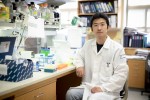UCLA researchers discovered how to transform normal cells into cancer cells, allowing for the development of therapies against aggressive forms of cancer.
In a study published Thursday, UCLA researchers in the lab of Owen Witte, professor in the Department of Microbiology, Immunology and Molecular Genetics, discovered how to manipulate the genes in normal prostate and lung cells to turn them into an aggressive form of cancer. They inserted a combination of five genes, referred to as PARCB, into a cell to change the function of commonly mutated proteins in cancer cells.
Understanding how these cancers develop will allow researchers to identify treatments for them, said Jung Wook Park, a postdoctoral scholar in the Witte lab and the lead author of the study.
These aggressive cancers, known as small-cell cancers, are difficult to study because they are rare, Park said. They are also hard to treat because they are resistant to many common treatments, like chemotherapy, he added.
“The big issue in cancer biology is we have treatments, but (cancers) find an escape mechanism,” Park said.
To try to understand how these cancers developed, the researchers created the PARCB combination. Adding PARCB to normal prostate cells caused them to turn into small cell cancer cells. Prostate cells with PARCB introduced formed tumors in mice and showed genetic activity similar to small-cell cancers from human patients, Park said.
To see if the same genetic combination worked on other tissues, Park said he also used the combination on normal lung cells. He said he was surprised to see the same combination turned normal lung cells into cancer cells, too. Since publishing the study, he said he has seen the same result in many different types of tissue.
The research suggests that many small-cell cancers share similar genetic characteristics despite originating from different types of tissue, said Katherine Sheu, an MD/ Ph.D. student and coauthor on the study.
“You start with two different tissues, (prostate and lung cells), but (once they develop into small-cell cancers) you get a very common (genetic) profile and (physical appearance), too,” Sheu said.
To understand why small-cell cancers looked so similar, Sheu studied the DNA of PARCB cells. The PARCB combination changed how DNA is stored in cells, she said. Genes that cause cells to behave like prostate or lung cells became hidden and were inactivated, while genes that cause cells to resemble neurons were exposed and activated.
Thomas Graeber, professor of molecular and medical pharmacology and coauthor on the study, said he was not sure why small-cell cancers resembled neurons but suggested the new cell state allowed the cells to ignore the usual signals to stop dividing. These changes may be critical to understanding why small-cell cancers are so aggressive and hard to treat.
Graeber said these genetic changes serve as a molecular signature for small-cell cancers. Since small-cell cancers share similar characteristics regardless of the tissue of origin, doctors might be able to treat them by addressing their common modes of growth, Sheu said.
“The commonality (of small-cell cancers) suggest common characteristics that can be targeted,” she said.
Graeber and Park both said their labs are working to identify drugs and other ways to stop the growth of small-cell cancers. As cancers grow, they become more and more like small-cell cancers, Park said. Since more cancers are becoming resistant to treatment, small-cell cancers are becoming more common, Graeber said.
“Now that we have (small-cell cancer) cell lines, we can test for small-molecule inhibitors (to stop the growth of these cancers),” Park said.
